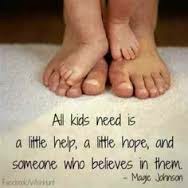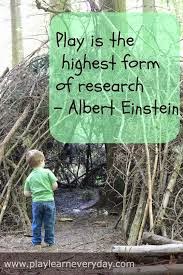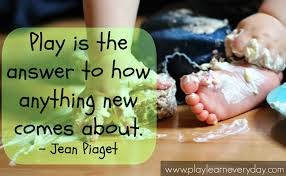The first resource I read this summer was "Authentic Childhood". It was an easy read (even though quite wordy). If you are looking for more information about the teaching practices of Reggio, I recommend that you take a look at this resource. It goes through the fundamental principles of this approach. Although Reggio in its purest form may be a challenge to bring into the classroom (ie. different culture, different community, different curriculum, most schools don't have access to the outdoor space as part of the classroom), I do believe it can be a positive influence on our teaching.
The Reggio approach encourages teachers to teach the whole child. It encourages us to view the child differently-as a being who comes into the school environment with a wealth of knowledge, ideas and reasoning. We as teachers need to honour their voices and listen. The teacher is not at the centre of the program. I would have told you in years passed that I did honour the children and listen to them. But my definition of a child centred classroom has changed. When I reflect now, I do see that much of my day was teacher-directed (teaching to children whole group or small group). I did most of the talking and I asked the questions. This philosophy is different as the children do most of the talking and they ask the questions. Does the teacher still teach? Of course! The way we teach changes- we become more of a provocateur. We provoke students with putting items out to explore. We expose children to things that encourage them to wonder and inquire about. We help students communicate their thinking and we ask questions to encourage deeper thinking and understanding. The big difference is that the teacher really listens and values the input of children- the children direct and negotiate with the teacher what happens next.
The Reggio experience also honours the environment. Reggio teachers bring items such as pinecones, leaves, twigs and rocks into the classroom to have students learn about nature and use nature in their work. Through exposure and experience with nature, these teachers believe that students will develop an appreciation and a relationship with the environment. In today's world of technology and structured after-school activities, I can see a need for this. I often wonder how many children are actually outside exploring the world around them. How many families regularly explore forests, pick up twigs and make crafts, build forts in the trees or collect bugs in jars? I can understand why these teachers feel it will help students build a relationship with nature, especially when technology for entertainment is huge in our world. I got a taste of how much technology is a part of my students lives when I did a partner activity on energy last spring. The students were asked to describe activities they could do while camping. Many of my students drew or wrote that they would play their DS, ipod or watch movies on the ipad. Only two teams reported that they would go for a walk in the woods and roast marshmallows.
The teachers of Reggio also believe in transparency-using light to learn about objects and colour. This is why many of our FDK classrooms use a light table or projector to have students explore shadow, colour and light. This transparency also applies to parent communication and involvement. They make student learning visible through documentation with photos, videos and scribing conversations of students and teachers. They record the process of the learning not just the end product. They encourage parents and members of the community to bring their knowledge to the classroom, whether it is photography, art etc... They use the parents to help teach the children in areas of inquiry. I love that relationships are built with the parents- a true partnership develops as both parties are involved in the learning process. My plan for next year is to ask parents on Program night what they could bring to our room- maybe there will be some expert gardeners in the group, an architect for structures, a music enthusiast etc... I would love to have more opportunities where parents join the classroom, take place in the learning and celebrate successes.
The principles of Reggio Emilia teaches the whole child. The children learn self-regulating skills as students work together to discover concepts and share ideas. They learn social graces, ways to problem solve and importantly how to manage their own behaviour. Relationships with the community, parents and environment are developed. The program recognizes the importance of multiple intelligences as it encourages children to show their learning in a way of their choosing whether it be drawing, in 3D form, diagram, painting or writing etc.. It honours student voice as areas for inquiry are student-driven and the ideas of students are valued. It encourages children to share their thoughts with others, test their hypothesis and question results. As a teacher, I am excited to see what these principles will bring to my own teaching and classroom experience. I encourage those teachers interested, to explore these principles and consider adopting some of these practices for September. I am excited to learn more and plan for this new journey ahead...
The Reggio approach encourages teachers to teach the whole child. It encourages us to view the child differently-as a being who comes into the school environment with a wealth of knowledge, ideas and reasoning. We as teachers need to honour their voices and listen. The teacher is not at the centre of the program. I would have told you in years passed that I did honour the children and listen to them. But my definition of a child centred classroom has changed. When I reflect now, I do see that much of my day was teacher-directed (teaching to children whole group or small group). I did most of the talking and I asked the questions. This philosophy is different as the children do most of the talking and they ask the questions. Does the teacher still teach? Of course! The way we teach changes- we become more of a provocateur. We provoke students with putting items out to explore. We expose children to things that encourage them to wonder and inquire about. We help students communicate their thinking and we ask questions to encourage deeper thinking and understanding. The big difference is that the teacher really listens and values the input of children- the children direct and negotiate with the teacher what happens next.
The Reggio experience also honours the environment. Reggio teachers bring items such as pinecones, leaves, twigs and rocks into the classroom to have students learn about nature and use nature in their work. Through exposure and experience with nature, these teachers believe that students will develop an appreciation and a relationship with the environment. In today's world of technology and structured after-school activities, I can see a need for this. I often wonder how many children are actually outside exploring the world around them. How many families regularly explore forests, pick up twigs and make crafts, build forts in the trees or collect bugs in jars? I can understand why these teachers feel it will help students build a relationship with nature, especially when technology for entertainment is huge in our world. I got a taste of how much technology is a part of my students lives when I did a partner activity on energy last spring. The students were asked to describe activities they could do while camping. Many of my students drew or wrote that they would play their DS, ipod or watch movies on the ipad. Only two teams reported that they would go for a walk in the woods and roast marshmallows.
The teachers of Reggio also believe in transparency-using light to learn about objects and colour. This is why many of our FDK classrooms use a light table or projector to have students explore shadow, colour and light. This transparency also applies to parent communication and involvement. They make student learning visible through documentation with photos, videos and scribing conversations of students and teachers. They record the process of the learning not just the end product. They encourage parents and members of the community to bring their knowledge to the classroom, whether it is photography, art etc... They use the parents to help teach the children in areas of inquiry. I love that relationships are built with the parents- a true partnership develops as both parties are involved in the learning process. My plan for next year is to ask parents on Program night what they could bring to our room- maybe there will be some expert gardeners in the group, an architect for structures, a music enthusiast etc... I would love to have more opportunities where parents join the classroom, take place in the learning and celebrate successes.
The principles of Reggio Emilia teaches the whole child. The children learn self-regulating skills as students work together to discover concepts and share ideas. They learn social graces, ways to problem solve and importantly how to manage their own behaviour. Relationships with the community, parents and environment are developed. The program recognizes the importance of multiple intelligences as it encourages children to show their learning in a way of their choosing whether it be drawing, in 3D form, diagram, painting or writing etc.. It honours student voice as areas for inquiry are student-driven and the ideas of students are valued. It encourages children to share their thoughts with others, test their hypothesis and question results. As a teacher, I am excited to see what these principles will bring to my own teaching and classroom experience. I encourage those teachers interested, to explore these principles and consider adopting some of these practices for September. I am excited to learn more and plan for this new journey ahead...






0 comments:
Post a Comment